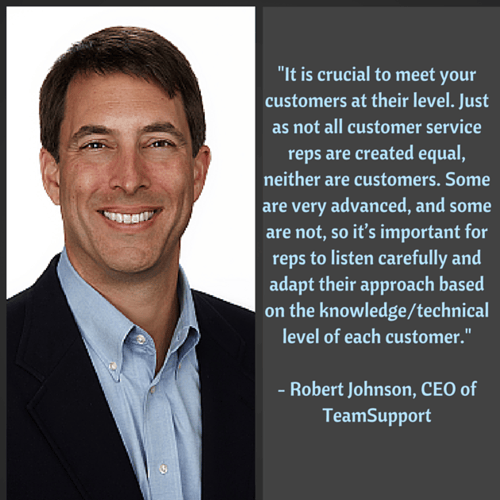Q&A: Serving Empowered Customers in 2016

Customer service is tricky in 2016 because there are more channels than ever before that businesses need to pay attention to and utilize for responding to customer comments and complaints.
In the past, businesses simply needed a live chat button and/or contact form on their website, but now they also to be prepared to meet customers in the channels they prefer - including mobile and social. TeamSupport's CEO Robert C. Johnson is shedding light on the evolution of customer service and how both B2B and B2C businesses can better serve today's empowered consumer below:
1) How has digital customer service evolved over the last few years?

Robert C. Johnson, TeamSupport: Customer service organizations are finally starting to realize that technology is an enhancement to customer service, not a replacement. For example, it wasn't that long ago that we saw the rise of chat and self-service options, but there was a disconnect. Businesses saw it as a replacement for customer service teams that were still seen as cost centers rather than profit centers, and many customers were forced to use those channels rather than speaking to a live person, resulting in unhappy and even lost customers.
Although we still see this to some extent today, successful customer organizations are realizing that instead of forcing customers into one channel, they can offer many choices and let the customer decide how to connect. This flexibility creates much higher customer satisfaction, and as a result, tends to reduce costs anyway - at the very least, it makes for longer-term customers. We're also starting to see the arrival of visual support through the use of video. Using video in customer support has huge benefits, from simplifying complicated questions and solutions through video and screen recording, to providing a personal touch through agent-to-customer video chat. The use of product videos, or even training videos has also improved customer service by making the information available on-demand and offsetting some of the workload from customer service reps who can now focus on more complicated solutions.
Additionally, the technology has evolved to a point where customers expect a true omnichannel experience. No matter how they contact a company - phone, email, Web portal, live chat or even social media - they expect the same level of response and that information moves seamlessly between the channels. The days of separate systems for different channels are almost gone, and this is a great thing for customers.
2) Why are customers more "empowered" in 2016?
Johnson, TeamSupport: It has become incredibly simple for anyone to find the information they need on the Internet, not only via computer but on mobile phones and other devices as well. The most common reaction to a question these days is "Google it" or "ask Siri" - that's just the way our world is today. This customer independence provides avenues for self-guided learning and self-diagnosis of issues that simply weren't available 20 or 30 years ago. It's also very easy to compare different products and vendors, or to get real customer reviews on any company or service. Knowledge is power, and as consumers gain access to more and more information at their fingertips, they become equally more empowered.
Companies are listening to customers much more so than in the past. One of the reasons is the rise of social media for consumers, and product review sites for businesses. If a customer is unhappy with the product or service, their voice can now be heard very loudly and this has direct impact to the vendor. Smart vendors are addressing complaints like this, but more importantly, moving to ensure their customers are satisfied with exceptional customer support.
3) How can customer service representatives better serve empowered customers in 2016?
Johnson, TeamSupport: It is crucial to meet your customers at their level. Just as not all customer service reps are created equal, neither are customers. Some are very advanced, and some are not, so it's important for reps to listen carefully and adapt their approach based on the knowledge/technical level of each customer. A customer who asks for help with reconfiguring their transmitter does not want to be told "press the power button," whereas a customer who says "the red thing with the weird wires is making a strange noise" likely needs a bit more hand-holding. No matter their aptitude, it is important to remember that most customers today have become accustomed to faster, better, more. It is a byproduct of our rapidly evolving marketplace and customer service teams need to understand that and work to meet customer expectations. Managing expectations is key, and that involves understanding their needs and wants, listening effectively, and providing clear, accurate details on what the next steps are and an expected timeline. Support agents are the 'front line' and are the most direct representation of a company's philosophy and ethos to the customers. Understanding this, and empowering agents to address customer's needs, will benefit the company and lead to stronger growth and more sales over time.

4) How can companies make sure their customer service team gives them a competitive edge?
Johnson, TeamSupport: The most important thing companies can do to make customer service a competitive advantage is to make it the responsibility of the entire company. Customer service is not a department, it's a culture. Companies who focus on customers first in every aspect of their business, from sales to customer support, to finance, will realize greater customer satisfaction, improved profitability, and stronger growth. Think of every interaction with a customer as an opportunity to impress them, and always be working on new ways to solve problems for them or make their lives easier.
5) What is the biggest difference between B2C and B2B customer support?
Johnson, TeamSupport: There are really three key differentiators: First, B2B customer support issues are typically much more complicated than those in B2C support and as such they take longer and often require collaboration to resolve. Second, B2B support tends to have a lower volume of higher value (and higher accountability) customers. For example, if you provide B2B software and your product fails, it affects your customers' business as well, versus in B2C where only the individual consumer is affected. Finally, each customer may have tens, hundreds, or even thousands of contacts at the same company, and they expect you to understand their business. This means visibility into current and past interactions, knowledge about their industry, and even understanding their own customers' needs. In B2B it's not just about your customers, it's about your customers' customers as well. We have a great infographic on this which can be found here.








